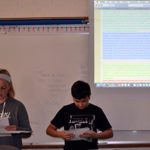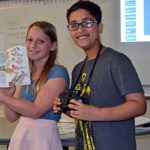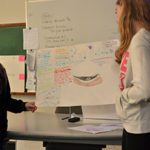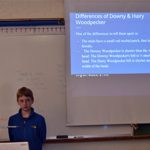On June 6th, three NRCM staff members took a trip to Windham and Gorham middle schools to get the inside scoop on how their “Engaging Maine Middle School Students in Protecting the Nature of Maine” grant projects are shaping up.
NRCM staffers had a fantastic time this Monday as we visited Windham and Gorham middle schools. Windham was our first trip: this group, led by teacher Helen Hurgin, has used their NRCM grant funds to purchase bird feeder stations, placed right outside their classroom window, as well as trees and seed to facilitate more bird activity. As we walked into the classroom, students immediately introduced themselves and pointed to their individual bird projects. Each student made a booklet researching an individual species, and they were clearly very proud of their work! Students in this group were excited to share what they’d been up do and gave us a presentation on some of the birds they observed and how they learned to tell them apart using their new Bird Identification guides purchased with the grant. We even were privy to a short skit about how they have gone about observing and identifying species. Not only are Windham students budding birders, but they are actors, too!
Here are some photos from our visit to Windham Middle School. You can enlarged each photo by clicking on them:
Next, we drove a quick 15 minutes away to Gorham Middle School, where a completely different but equally exciting project was occurring outside the walls of the school. Students in this group, spearheaded by teacher Angela Gospodarek, are working on a project entitled “Hometown Ecology,” where they examine the forests right next to their school, looking at and measuring forest and soil health as well as tree diversity and abundance. First, we got to watch an entertaining and educational video produced by the students, who spoke clearly and concisely about what they learned, without any scripts or prompts. The forest featured in this video looked rich, dense, and deep, but when Mrs. Gospodarek took us outside to visit the site, we were surprised to see that it was a stand of trees in the school’s “bus circle,” mere feet from the school entrance. It was exciting to see what a group can do with such a “small” plot of forest!
Both these projects made one point incredibly clear: when students are given the time and resources to experience the outdoors and authentically interact with the environment, it changes the way they experience and live in the world. Students who had never thought twice about their bus circle now understand the marvelous diversity of this tiny ecosystem. Students for whom bird calls previously faded into background noise now sit at their bus stop and are attuned to all the tiny creatures chirping and flying around them. Clearly, these projects are sowing the seeds for future environmentalists, and we can’t wait to visit the remainder of the projects!














Leave a Reply